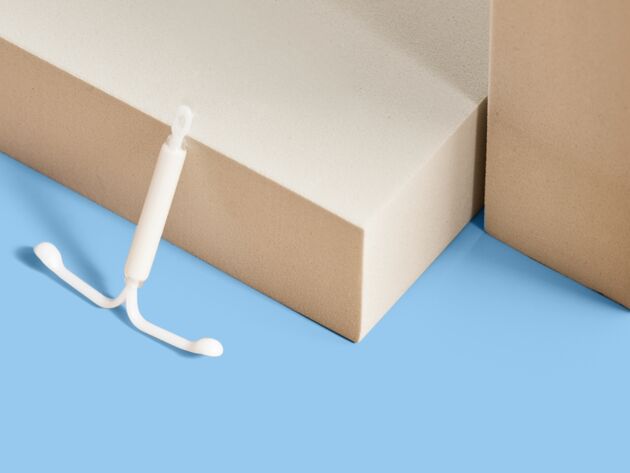How Do You Know if Iud Fell Out

Written by Michelle No
The number of women and people who menstruate who use an IUD (or coil) has increased dramatically in the last decade. And it'south no surprise — IUDs are incredibly constructive at preventing pregnancy and require little maintenance.
Read on for our guide to getting an IUD and what to do if yours falls out (also known as "expulsion"). Remember: Your health intendance professional person is the best first point of contact for all things contraception, so volume an appointment as a starting point.
What is an IUD?
Let's start with the basics: An intrauterine device (IUD) or coil is a small, T-shaped device that is placed inside the uterus to prevent unplanned pregnancy. There are ii different types to choose from: a non-hormonal IUD that'due south covered in copper and a hormonal IUD that releases progestin (a synthetic course of the hormone progesterone).
IUDs accept become hugely pop for people who apply contraception, in part considering they're hassle-gratuitous, long-lasting, and 99 percent effective at preventing pregnancies when professionally inserted. It'due south a win-win-win situation.
How does an IUD work?
The two types of IUDs may look similar, but they really work in pretty different ways.
A non-hormonal copper IUD works by releasing copper ions, which repel sperm and continue them from reaching an egg.
On the other hand, a hormonal IUD prevents pregnancy in several ways. Information technology thins the lining of your uterus, which makes it harder for a fertilized egg to attach, and information technology thickens the mucus around your cervix (the lower terminate of the uterus), making information technology harder for sperm to get through. On top of all that, the progestin released past the IUD also stops ovulation, meaning your ovaries won't release an egg that could potentially be fertilized. The hormonal IUD is also approved by the Food and Drug Administration (FDA) for treatment of heavy menstrual bleeding. Pretty cool.
Why practice IUDs have strings?
If you've always seen an IUD, you've probably noticed the two minor pieces of string dangling from the bottom. Those strings are actually an essential part of the IUD's blueprint. They aid you bank check that your IUD is in place and help the doctor remove it when the fourth dimension comes. Call back of them like the strings on a tampon.
Have a quiz
Find out what you can practice with our Health Assistant
What's IUD insertion like?
IUD insertion starts off like many trips to the gynecologist. To begin, a nurse or doctor will ask you about your medical and sexual history. They might also perform a pelvic examination, which might include using a swab to collect a sample of cervical cells. If this is the case, your md should explicate the test beforehand so you understand what it entails and can fully consent.
And then, they'll utilise a speculum to gently open the walls of your vagina and a tool called a tenaculum to stabilize the cervix. Before they can insert the IUD, they'll need to measure your uterus so that they can insert the IUD correctly. Then they'll use another tool to guide the IUD into the uterus. When the IUD reaches the correct depth (indicated by uterine sound), the IUD is pushed out of its tube and immune to open into the "T" shape you're familiar with. Stabilizing the neck, measuring the uterus, and inserting the IUD can all cause cramping. For some people, it'due south a walk in the park, just for others, information technology can injure quite a lot (but only very briefly!). Some doctors recommend taking a pain reliever earlier your appointment, only in case.
How can I expect to feel later an IUD insertion?
Your body is unique, so how you feel later on an IUD insertion might vary a lot from how someone else feels. You might not feel any side effects at all, or you might experience cramps or backaches. Spotting is likewise a common side issue. All of these sensations are completely normal.
Boosted side effects depend on what kind of IUD y'all had inserted. If you had a copper IUD inserted, then your period might become heavier and your cramps more than intense. Alternatively, if yous opted for a hormonal IUD, you might have lighter periods or notice your period stops altogether. Again, this is normal.
What if I can feel my IUD strings coming out (or tin't experience them at all)?
At present, IUDs are pretty reliable — that's why and so many people opt for them. But hey, things happen, and your IUD could fall out. If your IUD'southward strings feel longer or shorter than usual, or you can't feel the strings at all, information technology'southward possible that your IUD has moved or fallen out. But don't freak out: It'due south also possible that the strings have folded on themselves and simply aren't within attain or that the IUD has moved a piffling higher.
The only way to be sure is to make an engagement to get it checked out. But remember that, generally speaking, if your IUD has moved or been expelled, and then it won't prevent pregnancy. If it'southward shifted to a lower part of your uterus, then it may nonetheless exist effective. However, if you lot suspect it'due south moved, information technology's a practiced idea to consult your doctor. Until your appointment, you should employ a backup grade of birth control (such as condoms) while you wait for your doctor to give you the all-clear.
These are some signs your IUD has moved or been expelled:
- Discomfort during sex
- A alter in menstrual bleeding
- Increased cramping

Why has my IUD moved or been expelled?
While most IUDs never move, IUD expulsions (when IUDs fall out) do occur in 2–10 percent of patients. And it's quite easy to encounter why they happen when you consider that the uterus is a muscle that contracts.
Dr. Barbara Levy, Clinical Professor of Obstetrics and Gynecology at the George Washington Academy School of Medicine and Health Sciences (and Flo Medical Board member), explains that "for some, this muscle contracts very, very firmly." That's oft when expulsions happen because the uterus contracts around the IUD and pushes information technology toward the cervix.
Every bit logic follows, people with heavy bleeding or heavy cramping or people who might have an uneven uterine surface might be more probable to expel their IUD. In these cases, the muscles are either contracting harder than usual or aren't able to hold the IUD in identify, she says.
According to Dr. Levy, another gene that can make up one's mind whether you might be more probable to expel your IUD is if your torso has a greater production of prostaglandin, which is the chemic that causes the uterus to contract.
That said, people who are virtually likely to take their IUDs fall out are patients aged 14–19 years.
Tin an IUD fall out without you knowing?
It'south rare, says Dr. Levy, but it'due south possible to pass your IUD through a blood jell — without fifty-fifty realizing information technology — if y'all're someone who has a very heavy flow. The key word here is "rare."
By and large, if your IUD falls out, you'll feel the plastic or the strings of the IUD or experience some cramping. "It's more than probable that y'all'll feel some symptoms associated with the expulsion," says Dr. Levy.
How tin I check if my IUD is notwithstanding in identify?
To check that your IUD hasn't prematurely left your uterus or moved, you should try to regularly check your IUDs strings in the first few months after it'south been inserted. Simply remember not to pull on the strings, or you could accidentally remove information technology yourself!
To cheque if your IUD is nonetheless in place, wash your easily, squat or sit down, then slowly insert a finger into your vagina. Y'all might not feel the strings right away, in which case, you might desire to attain a little higher. If you even so don't feel the strings, then schedule an appointment with your health intendance professional person to make certain everything is in the right place. And again: Only be sure to use another method of contraception (such as condoms) until yous go the all-clear.
What happens if my IUD isn't in my uterus?
If you've checked for strings and gone to a physician for an ultrasound, and you and your md still tin can't locate your IUD, and so the adjacent stride might be to exercise an X-ray. Perforation of the uterus with an IUD is extremely rare, but it does happen. Given just how rare it is, though, Dr. Levy recommends not worrying too much virtually the possibility.

Source: https://flo.health/menstrual-cycle/sex/birth-control/iud-expulsion
0 Response to "How Do You Know if Iud Fell Out"
Post a Comment